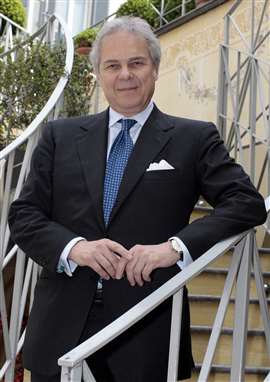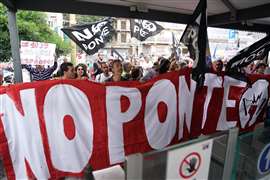Could 20-year-old plans for the world’s longest suspension bridge finally move forward?
11 October 2023
Italy’s recently-elected government is hoping to revive 20-year-old plans for a Webuild-led consortium to build the world’s longest suspension bridge linking Sicily to the Italian mainland. But many in Italy remain skeptical that the €13.5bn engineering masterpiece will ever be built. Lucy Barnard reports on the political saga behind the megaproject.
Italy’s largest contractor has said that it is ready to resume work on the world’s longest suspension bridge linking the island of Sicily with the Italian mainland.
Pietro Salini, chief executive of Webuild, said that he hoped to start construction work on a 20-year-old plan to build a single span suspension bridge linking the village of Torre Faro in Sicily with the port city of Villa San Giovanni in Southern Calabria next year after the stalled project received backing from Italy’s new far right-led government.
At the Presidential Meeting of the Associazione Nazionale Construtti Edili (ANCE), the Italian Association of private construction contractors, Salini described the controversial and ambitious Strait of Messina Bridge plan, first agreed in 2006, as “an innovative, strategic and immediately implementable project.”
 Eurolink’s proposed single span suspension bridge would be the longest in the world. Image: Reuters
Eurolink’s proposed single span suspension bridge would be the longest in the world. Image: Reuters
Certainly, on paper, the megaproject is impressive. Webuild hopes to build a suspension bridge across the Strait of Messina, with a central span of 3,300 metres – 60% longer than the current record holder, the 1915 Çanakkale Bridge in Turkey which has a central span of 2,023 meters. Moreover, the pylons holding the bridge up will be higher than the Shard tower, measuring 382.6 meters (1,255 feet), making it also the world’s tallest suspension bridge.
The project comprises a six-lane motorway – two lanes plus a hard shoulder for each direction of travel as well as two railway tracks. The designers say this will allow 6,000 vehicles an hour to cross and 200 trains a day. With a span around 74 meters above sea level and a navigation channel of 600 meters, the designers say it would allow cargo vessels and even the tallest cruise ships to pass. And on the mainland the bridge is designed to link to the Salerno-Reggio Calabria motorway (A3) and the planned Naples-Reggio Calabria high speed railway line.
Salini said Webuild and its consortium partners were ready to provide supplementary documents for the project which include a technical multi-disciplinary report, enabling the project to conform to new environmental and safety rules.
“A decade since work stopped in 2013 and with more than 50 years of work already done, with analyses, studies, investments to carry out the project, which has already passed all exams, both national and international, we can only be satisfied to see that the project is advancing as it will be the driving force for growth for the South of Italy and Italy as a whole,” he said.
“We hope that the fulfilment of all the steps that will come will allow Italy to start activities before summer 2024.”
Giorgia Meloni backs the Messina Strait Bridge
The reason for Salini’s renewed optimism is clear: Italy’s new far right prime minister Giorgia Meloni is backing the mega project. In her first budget since taking office last year, Meloni reinstated the Strait of Messina SpA, the state-owned company created to oversee the construction and operation of the bridge.
And it is Meloni’s political ally, transport and infrastructure minister Matteo Salvini who has become the project’s biggest cheer leader.
Just days after assuming office in October 2022, Salvini announced that pressing ahead with decade-old plans to complete the mega-project would be a priority for his term in office.
“Over the next five years, starting work on the construction of the Strait Bridge is one of my goals,” he told Italian state broadcaster Rai. “The transshipment of ferries, in addition to pollution and waste of time, costs people more in a year than it would cost to build the bridge.”
 Webuild chief executive Pietro Salini says the Messina Strait Bridge is as “an innovative, strategic and immediately implementable project” Photo: Reuters
Webuild chief executive Pietro Salini says the Messina Strait Bridge is as “an innovative, strategic and immediately implementable project” Photo: Reuters
Salvini’s vision is that it could provide a vital trade route, enabling cargo ships from the Suez Canal to offload goods in Sicily, from where high-speed trains would transport them to northern Europe. The project, he says, would provide much needed jobs to Italy’s poorest regions and provide an economic boost for the ‘Mezzogiorno.’
Moreover, although Webuild’s involvement in the revived project is not a given, Salvini has made it clear that he would like to honour the original contract.
After Italian media reports suggested that China Communications Construction Company (CCCC) was interested in taking on the project, Salvini told reporters at the Foreign Press Association in Rome, that the government had “received expressions of interest from all over the world including China.”
“I’m happy that there is an interest from many subjects from all over the world,” he said, adding that the 2006 tender winners were “the ones who will likely continue with the final version of the project.”
Then known as Salini Impregilo, Webuild owns a 45% stake in Eurolink. The remainder is owned by Spanish infrastructure company Sacyr which has a 18.7% stake; Condotte d’Acqua (now part of Webuild) has a 15% stake, Italian construction company CMC has a 13% stake, Japanese construction company IHI has a 6.3% stake and Italian infrastructure specialist Consorzio ACI has a 2% stake.
But building the longest suspension bridge in the world comes with many challenges.
The Strait of Messina is one of the most seismically active areas in the Mediterranean, lying on a fault line between the African and Eurasian tectonic plates. In 1908 the area was the site of the most destructive ever to strike Europe which destroyed the cities of Messina and Reggio Calabria, killing between 75,000 and 82,000 people.
Webuild and COWI’s original plan specifies that the bridge will be fitted with a buffer, allowing the deck to flex in the event of an earthquake while the structure is kept in place by two vast concrete and steel anchors comprising 5.5 million cubic meters. The designers say these measures mean the structure could withstand an earthquake with a magnitude of 7.5 on the Richter scale (the 1908 quake measured 7.2)
Strong winds too pose a problem for any structure. The Strait of Messina regularly experiences gales of up to 100 kilometers an hour.
To combat this, lead designer Dr William Brown created plans for the Messina Strait Bridge to comprise a deck split into three separate wedge-shaped aerodynamic decks, reinforced by crossbeams every 30 meters. According to the plans, which COWI says it has tested extensively in wind tunnels, the shape of the boxes means that wind is deflected and pushed through the gaps between them, enabling the bridge to withstand gusts of up to 300 kilometers an hour.
‘No Ponte’ demonstrations
Over the years ‘No Ponte’ demonstrations in Messina have attracted thousands of protestors, angry that the proposed bridge would damage the environment and waste taxpayers’ money.
The ‘No Ponte’ movement’s Facebook page alone has 4,000 likes and 4,600 followers. A Change.org petition to stop the bridge had attracted 41,852 signatures when checked in early October.
In April, the Italian Treasury published figures in its Economic and Financial Document forecasting that construction costs for the bridge itself had risen to around €13.5bn while another €1.1bn would be needed to improve rail links. It also said that the government aimed to find the money for the bridge from the budgets of regional governments, state funds to be allocated in next year’s budget law and subsidies from the EU’s Connecting Europe fund. And critics argue costs are likely to be even higher if the bridge actually starts construction.
 ‘’No Ponte’’ protesters show their disagreement with the conference organized by the CISL chaired by Minister Matteo Salvini. Messina (Italy) June 6, 2023 (Photo by Gabriele Maricchiolo/NurPhoto)/ Reuters
‘’No Ponte’’ protesters show their disagreement with the conference organized by the CISL chaired by Minister Matteo Salvini. Messina (Italy) June 6, 2023 (Photo by Gabriele Maricchiolo/NurPhoto)/ Reuters
Moreover, they say that in order to transport goods at speed across the bridge, Sicily’s current internal road and rail network would require an expensive upgrade.
Environmentalists too say the bridge would cause irreversible damage. WWF-Italy says that the area around the Strait of Messina borders one of the three most important migration routes for storks and cranes. When the bridge was first proposed, the group filed a formal complaint with the European Commission asking the European Court of Justice to force the Italian government to scrap the scheme.
Another major concern is that the project could become a target for organised crime. Sicily is famous for its Cosa Nostra mafia while Calabria is home to its own ‘Ndrangheta network, which is thought by Italian prosecutors to be even larger and more powerful.
Yet, so far, the biggest challenge to the bridge being built has been Italian politics.
Over the past 20 years, the bridge has become strongly politicised – broadly supported by those to the right of Italian politics who see it as a symbol of Italian nationalism - and opposed by those to the left.
Back in 2006, populist prime minister Silvio Berlusconi was the driving force behind the megaproject. Berlusconi made building the bridge a core election pledge as part of his 2001 election campaign and subsequently swept to power with a landslide victory.
During Berlusconi’s premiership, Stretto di Messina, the government-owned body responsible for procuring and operating the crossing, awarded a design, build, operate, transfer (DBOT) contract to build it to a the Eurolink consortium, led by Webuild, which was then valued at €3.9bn.
Strongly politicised
However, shortly after the contract was awarded, Berlusconi’s government fell and his successor, leader of the centre-left coalition Romano Prodi, abandoned the project. At the time Italy’s then-transport minister Alessandro Bianchi described it as “the most useless and damaging project in Italy for the past 100 years.”
When Berlusconi returned to power in 2008 he tried again to revive the project, which was approved again in 2011. However, again his government fell shortly afterwards and, under pressure to curb public spending during the 2012 sovereign debt crisis, his successor Mario Monti formally cancelled the project, prompting a lawsuit from Eurolink that has never been settled.
Before he died in June 2023, Berlusconi, an ally of the Meloni government, continued to voice his support for the bridge. “The bridge remains my priority,” he told supporters before the 2022 election when Giorgia Meloni’s government came to power.
And so, as yet another right-wing Italian government attempts to revive the plans, many ordinary Italians are growing skeptical that the bridge plans are anything more than political grandstanding by right wing populist politicians eager to win support in Italy’s poorest regions.
Sociologist Aurelio Angelini, author of the book ‘The Mythical Bridge,’ speaks for many: “Perhaps [the bridge saga] is the result of a polarization of politics. Perhaps it is an opportunity to rise from the periphery of the political system, claiming the centrality of a target on the national agenda.”
STAY CONNECTED



Receive the information you need when you need it through our world-leading magazines, newsletters and daily briefings.
CONNECT WITH THE TEAM








